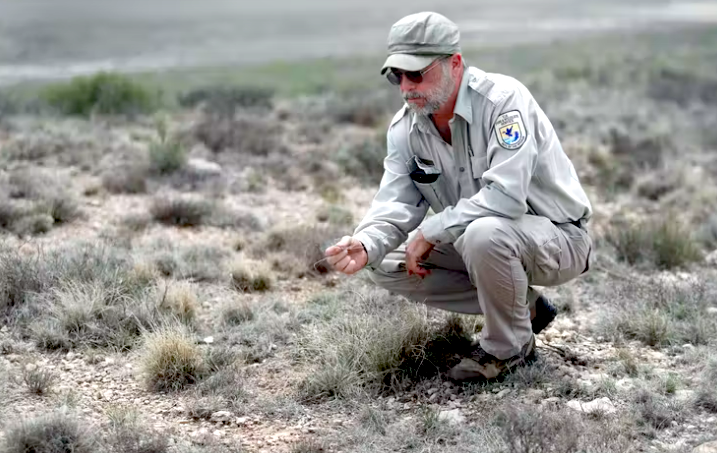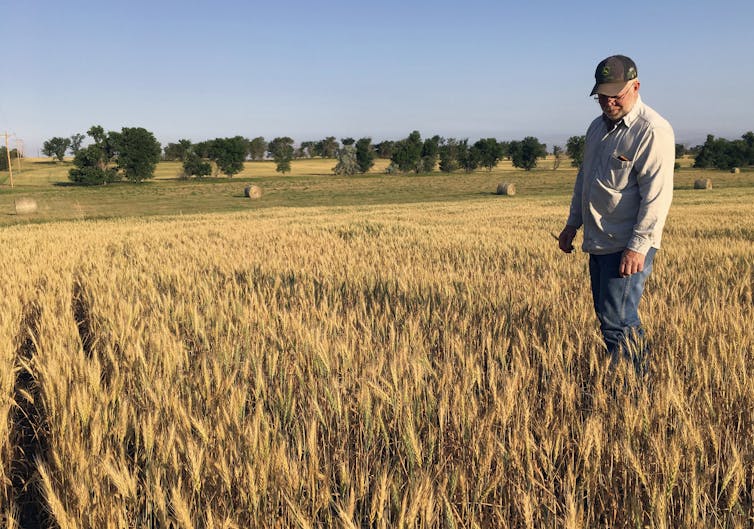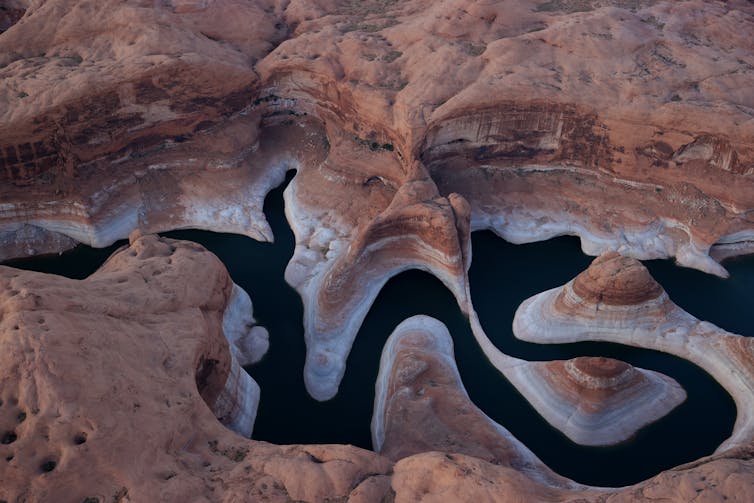Amid persistent La Niña conditions and a generally hotter, thirstier atmosphere, Imtiaz Rangwala describes the various forms of drought that lie ahead, some of which coincide with higher levels of precipitation.

Farmers in some regions are being encouraged to preserve and establish grasslands that can survive drought and protect the soil. (AP Photo/Mark Rogers)
By Imtiaz Rangwala
University of Colorado Boulder
 Much of the western U.S. has been in the grip of an unrelenting drought since early 2020. The dryness has coincided with record-breaking wildfires, intense and long-lasting heat waves, low stream flows and dwindling water supplies in reservoirs that millions of people across the region rely on.
Much of the western U.S. has been in the grip of an unrelenting drought since early 2020. The dryness has coincided with record-breaking wildfires, intense and long-lasting heat waves, low stream flows and dwindling water supplies in reservoirs that millions of people across the region rely on.
Heading into summer, the outlook is pretty grim. The National Weather Service’s latest seasonal outlook, issued May 19, 2022, described drought persisting across most of the West and parts of the Great Plains.
One driver of the Western drought has been persistent La Niña conditions in the tropical Pacific since the summer of 2020. During La Niña, cooler tropical Pacific waters help nudge the jet stream northward. That tends to bring fewer storms to the southern tier of the U.S. and produce pronounced drought impacts in the Southwest.
The other and perhaps more important part of the story is the hotter and thirstier atmosphere, caused by a rapidly warming climate.

As a climate scientist, I’ve watched how climate change is making drought conditions increasingly worse – particularly in the western and central U.S. The last two years have been more than 2 degrees Fahrenheit (1.1 Celsius) warmer than normal in these regions. Large swaths of the Southwest have been even hotter, with temperatures more than 3 F (1.7 C) higher. Studies suggest the Southwest’s ongoing 20-year drought is the most severe in at least 1,200 years, based on how dry the soils are.
Stress on Land
A thirstier atmosphere tends to extract more water out of the land. It exacerbates evaporative stress on the land, particularly when a region is experiencing below-normal precipitation. High evaporative stress can rapidly deplete soil moisture and lead to hotter temperatures, as the evaporative cooling effect is diminished. All this creates hydroclimatic stress for plants, causing restricted growth, drying and even death.
As a consequence of a warming climate, the U.S. Southwest has seen an 8 percent increase in this evaporative demand since the 1980s. This trend is generally happening across other parts of the country.
The thirstier atmosphere is turning what would otherwise be near-normal or moderately dry conditions into droughts that are more severe or extreme. As the climate heats up further, the increasing atmospheric thirst will continue to intensify drought stress, with consequences for water availability, long-lasting and intense heat stress and large-scale ecosystem transformation.
Climate models project ominous prospects of a more arid climate and more severe droughts in the Southwest and southern Great Plains in the coming decades.
In addition to direct impacts of increasing temperatures on future droughts, these regions are also expected to see fewer storms and more days without precipitation. Climate models consistently project a poleward shift in the midlatitude storm tracks during this century as the planet heats up, which is expected to result in fewer storms in the southern tier of the country.
Flash Droughts
The changing nature of droughts is a concern even in parts of the U.S. that are expected to have a net increase in annual precipitation during the 21st century. In a hotter future, because of the high evaporative demand on the land, prolonged periods with weeks to months of below normal precipitation in these areas can lead to significant drought, even if the overall trend is for more precipitation.
Large parts of the northern Plains, for example, have seen precipitation increase by 10 percent or more in the last three decades. However, the region is not immune to severe drought conditions in a hotter climate.
At the tail end of what was the wettest decade on record in the region, the northern Plains experienced an intense flash drought in the summer of 2017 that resulted in agricultural losses in excess of $2.6 billion and wildfires across millions of acres. Record evaporative demand contributed to the severity of the flash drought, in addition to a severe short-term precipitation deficit. A flash drought is a drought that intensifies rapidly over a period of a few weeks and often catches forecasters by surprise. The likelihood of flash droughts that can cause severe impacts to agriculture and ecosystems and promote large wildfires is expected to increase with a warmer and thirstier atmosphere.

During the 2017 flash drought, a North Dakota farmer stands in a wheat field that should have been twice as high at that point. (AP Photo/Blake Nicholson)
Flash droughts are also emerging as a growing concern in the Northeast. In 2020, much of New England experienced an extreme hydrologic drought, with low stream flows and groundwater levels and widespread crop losses between May and September. Aided by very warm and dry atmospheric conditions, the drought developed very rapidly over that period from what had been above-normal wet conditions.
As humanity enters a hotter future, prolonged periods of weeks to months of below-normal precipitation are going to be of a greater concern almost everywhere.
Unfamiliar Territory
Other forms of droughts are also emerging.
Atmospheric heating is causing snow droughts as more precipitation falls as rain rather than snow and snow melts earlier. Shorter snow seasons and longer growing seasons because of warmer temperatures are changing the timing of ecological responses.

The “bathtub ring” on Lake Powell, one of the nation’s largest reservoirs, attests to its falling water level over two decades of drought in Arizona. The Colorado River reservoir is crucial for water supplies and hydropower. (Justin Sullivan/Getty Images)
Land is greening up earlier and causing an earlier loss of water from the land surface through evapotranspiration – the loss of water from plants and soil. This could result in drier soils in the latter half of the growing season. As a result, parts of the central and western U.S. could see both increased greening and drying in the future that are seasonally separated across the growing season.
With a rapidly changing climate, we are entering unfamiliar territory. The world will need new ways to better anticipate future droughts that could transform natural and human systems.![]()
Imtiaz Rangwala is a research scientist in climate at the Cooperative Institute for Research in Environmental Sciences at the University of Colorado Boulder.
This article is republished from The Conversation under a Creative Commons license. Read the original article.
The views expressed are solely those of the author and may or may not reflect those of Consortium News.
Help Us Beat the Censors!
Donate to Consortium News‘
2022 Spring Fund Drive
Donate securely by credit card or check by clicking the red button:

Caleb Maupin’s Center for Political Innovation has a solution for this problem.
War in Europe Will Bring Hunger, Build The River of Life!: hxxps://cpiusa.org/news/war-in-europe-will-bring-hunger-build-the-river-of-life/
Never mind the drought, CNN just today aired an “alarming” story replete with satellite imagery which, according to CNN, proves that Russia is destroying Ukrainian grain silos to starve Ukrainians, and the world, of course they only presented one before and after photo of a destroyed silo, which could be anywhere, or it could have been a Ukraine weapons hideout destroyed by Russian missiles. Grain silos are notorious for self-exploding due to the combustibility of grain dust, and it is also possible that this is simply a false flag event.
CNN, on the same program, also claimed to have imagery of mass graves. CNN claims the satellite photos show that there could be as many as five thousand unmarked new grave sites somewhere (?).
This is, I believe, preparation for a new narrative to allow the US and / or other NATO countries (Poland?) to enter the Ukraine conflict on “humanitarian grounds” to prevent international starvation and mass murders. Time to get ready for World War Z.
I’m not American, but I distinctly recall America going thru similar period in the past when the Great Plains turned into a dust bowl. Funny thing, back then no one ever heard of global warming, nor was the atmosphere as severely effected back them as it has been today. So some explanation is due, as to why the drought occurred way back then, which today, has been total ignored, and today’s, which is a repetition of that event, however in this case, different causes are being blamed.
The real meaning of not keeping fossil fuels in the ground is that, from now on, every year for the rest of our lives and our children’s and their children’s lives will be worse for us climatically than the one before. In our lack of action, this is what we have chosen, or rather, this is what our leaders have chosen for us. This is my fury with the Biden (“America is back!”) admin for literally burning
Out of touch politicians such as the current “crop” who have resided living off the public teat are absolutely killing the country and have been since they settled in DC during the seventies.
Biden gave a recent address during which he extolled the greatness of the U.S. of A., which in and of itself was not a particular problem for me until he went over the top. He during his rant he made a statement which made my blood run cold with dread.
I’m superstitious. Sure go ahead and laugh. Fools! No human needs ever to tempt fate needlessly, I call it snake biting yourself!
So the POTUS, talking about planet wide food shortages promised the U.S. could and would fill those voids. Right at planting time here in the great mid west farming country. Currently the weather has been cool and too wet. Much more of this type weather will adversely impact crop production. Once grown to maturity these crops still must be harvested.
The following comes from a school fund raising T-shirt I acquired many years ago – author unknown-
“Only when the last tree is dead, the last river damned and the last field paved over will we (them dumb ass politicians and billionaires edt. addition) realize we can’t eat money .”
thanks CN
Quite interesting, I don’t think the concept and implications of evaporative stress and “flash droughts” are widely covered.
Do we need more of the evidence. NO.
We need action but none will be coming. More wars and propaganda is all we get.
Interesting that it coincides with Biden’s Deep State orchestrated ascension. Not that he can be directly blamed for it. Wonder if it’s a message to the American people from …. Naw, I’m not a believer, nor an atheist. But, …
I really want to commend Mr. Rangwala for so concisely and clearly explaining how quickly plants and watersheds are impacted by evaporative stress. It is easy to be in a city, see record rainfalls and have no clue as to the draught that is just around the corner from these heavy rainfalls. Get in a region where annual rains are barely enough to sustain life in the first place, and you see how quickly the desert floor and all that lives bakes to death. Even a climate denier would have to read this and say it does match reality on the ground. (Well, it ought to, anyway.) Certainly life-long farmers and ranchers know their world has changed and not for the better.
Continued growth of urban areas in already stressed regions is a recipe for disaster in short order, yet that is exactly what we are doing across the west. Population growth is good for the economy, but not our world.
2.6 Billion is a lot of money, and a big hit to the economy. In light of that, consider our government w/o our consent just spent 54 Billion on a foreign proxy war in Ukraine. That’s almost 21 times as much money as that drought disaster in the U.S. It’s so wrong and bad for America.
Maybe the thinking of our brainiacs in charge is that a nuclear war can have good consequences on the climate as well as the economy. Besides curbing inflation by spontaneously disappearing many of these superfluous dollars chasing diminished inventories of goods, the detonation of gigatons of nukes will change the tilt of Earth’s axis. If the tilt is reduced, the seasonal temperature fluctuations will be mitigated and the extreme highs and lows will flatten out. Of course, if the tilt is increased… Well, our great leaders don’t like to even consider failure which is why they are never talked about. Perhaps their thinking is that if we attack both Russia and China simultaneously with massive barrages of nuclear explosions, they can adjust the outcome with their usual fine precision. And the world thought American creativity was dead! We will always be heroes and indispensable to every living thing!
/Warning: For entertainment purposes only!/
Realist:
At last! An optimist! Thanks for presenting the sunnier side of our present moment.
Our “government” doesn’t give a rat’s ass about this country’s citizens. You can bet the elite will ride this storm out with no problems. Earth is such a stupid planet.
The real meaning of not keeping fossil fuels in the ground is that, from now on, every year for the rest of our lives and our children’s and their children’s lives will be worse for us climatically than the one before. In our lack of action, this is what we have chosen, or rather, this is what our leaders have chosen for us. This is my fury with the Biden (“America is back!”) admin for literally burning away the last few precious years we have left, just a handful now, to make any kind of difference. There are no more good opportunities once tipping points are reached and environmental feedback loops that will exacerbate negative climate effects even more are locked in.
Wars and human conflict ultimately come down to human decisions which can be bargained. But with the climate change that is now upon us, Nature herself sets the rules and there is no negotiating. Might as well try to stop the tide from rising. Through the most unfortunate set of circumstances possible, a perfect storm, the Biden admin arrived and it with all the people and entities it has drawn together is driving the US and all of humanity (it’s all the same planet) right off the cliff. And we are literally watching it happen right in front of our eyes. Go figure…
Biden is old and selfish. He either never believed in the climate change narrative or doesn’t care. From his earliest days as a politician, Biden has followed the pro-corporate neo-liberal narrative (they use to call themselves New-Democrats, or Clinton Democrats). It is all the same anti-human corporate bull shit. I am amused that anyone who knew Biden’s résumé would have thought he would fight the good fight for progressive principles.